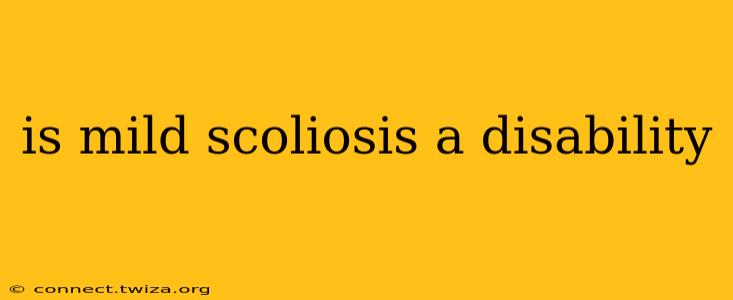Is Mild Scoliosis a Disability? Navigating the Complexities of Diagnosis and Qualification
Scoliosis, a sideways curvature of the spine, affects millions worldwide. The question of whether mild scoliosis constitutes a disability is complex and depends on several factors, making a simple "yes" or "no" answer insufficient. This article delves into the nuances of scoliosis and its impact, helping you understand the criteria for disability consideration.
What is Considered Mild Scoliosis?
Mild scoliosis is generally defined as a curvature of the spine measuring less than 25 degrees on a Cobb angle measurement, a standard method used by doctors to quantify the degree of spinal curvature. Curvatures below this threshold are often considered within the normal range of variation, although regular monitoring is still recommended. However, even mild scoliosis can cause symptoms in some individuals, influencing the potential for disability classification.
Does Mild Scoliosis Automatically Qualify as a Disability?
No, mild scoliosis does not automatically qualify someone for disability benefits. Disability determination involves a comprehensive assessment of the individual's functional limitations, not simply the diagnosis itself. The impact of the condition on daily activities plays a crucial role. This means that even with a significant Cobb angle, a person may not experience significant functional limitations, and vice versa. A person with mild scoliosis experiencing significant pain and limitations may have a stronger case for disability than someone with a more severe curve but few symptoms.
What Factors Determine Disability Qualification for Mild Scoliosis?
Several factors influence whether mild scoliosis might be considered a disability:
-
Severity of Symptoms: The presence and severity of pain, fatigue, and other symptoms are paramount. Even a mild curvature can lead to significant discomfort and functional limitations if it causes debilitating pain or other significant symptoms.
-
Impact on Daily Activities: The extent to which scoliosis affects daily living, including work, school, and personal care, is a key consideration. Difficulties with mobility, prolonged standing, or sitting can significantly impact an individual's ability to perform daily tasks.
-
Treatment Needs: The need for ongoing medical care, physical therapy, bracing, or surgery can contribute to disability consideration. The frequency and intensity of medical interventions needed to manage the condition directly impact an individual's ability to function.
-
Age: The impact of scoliosis can vary with age. Young children may experience different limitations compared to adults. The developmental stage and the potential for future progression of the curvature are also considered.
Can Mild Scoliosis Cause Significant Disability?
While often not considered severe, mild scoliosis can indeed cause significant disability in some individuals. The symptoms mentioned above, when severe, can impede someone's capacity for employment and participation in daily activities. This necessitates a comprehensive evaluation by medical professionals and disability assessment agencies.
How is Disability Related to Scoliosis Determined?
The determination of disability due to scoliosis typically involves a review of medical records, including radiographs showing the Cobb angle and a functional capacity evaluation. This evaluation assesses the individual's ability to perform various tasks, providing crucial evidence to support a claim. The specific criteria for disability differ depending on the country and the relevant disability program.
What are the Treatment Options for Mild Scoliosis?
Treatment options for mild scoliosis often focus on conservative management to monitor the progression and manage symptoms. These might include:
- Observation: Regular checkups to monitor the curvature.
- Physical Therapy: Strengthening exercises to improve posture and core stability.
- Bracing: In some cases, bracing might be recommended to prevent further progression.
Surgical intervention is generally not considered necessary for mild scoliosis unless there's significant progression or severe symptoms.
In conclusion, the question of whether mild scoliosis is a disability is not a straightforward one. It requires a thorough assessment of the individual's specific circumstances, including the severity of symptoms, impact on daily activities, and treatment needs. While mild scoliosis itself might not automatically qualify someone for disability benefits, its potential impact on functionality should be carefully evaluated on a case-by-case basis.
